7 Ways To Drive Operational Efficiency In HR
We all know Human Resources (HR) is under increasing pressure to deliver greater operational efficiency, while maintaining high levels of employee satisfaction and engagement. 95% of HR leaders reported an increase in their workload over the past year, and 91% have seen an increase in more responsibilities in their role.
HR departments must do more with less, juggling the demands of recruitment, employee management, and compliance, all while contributing to the broader strategic goals of the organization.
Luckily, cutting costs in HR doesn’t have to negatively impact performance. The integration of technology, particularly Artificial Intelligence (AI) and data-driven tools, plus new ways of working, can enable HR teams to streamline processes, make better decisions, faster, and optimize talent management.
Below are 7 key strategies to drive operational efficiency in HR, with a focus on the growing role of AI and consolidated skills data.
1. Automate routine tasks 🔁
One of the most effective ways to increase efficiency in any walk of life is by automating the straightforward tasks you do all the time.
Within HR, these might include repetitive, administrative functions such as payroll processing, benefits administration, compliance reporting, and onboarding.
Within Talent Acquisition specifically, teams can use technology to streamline processes such as candidate screening and interview scheduling, taking more time to focus on the tasks that require creativity, imagination and the human touch.
“90-95% of the recruitment process can be automated. It’s about getting those low value tasks out of the mix so that our recruiters can spend the time actually having the really rich, honest conversations with, with candidates, with hiring managers.” – Darren Peiris, VP & Group Head of Recruitment at National Grid
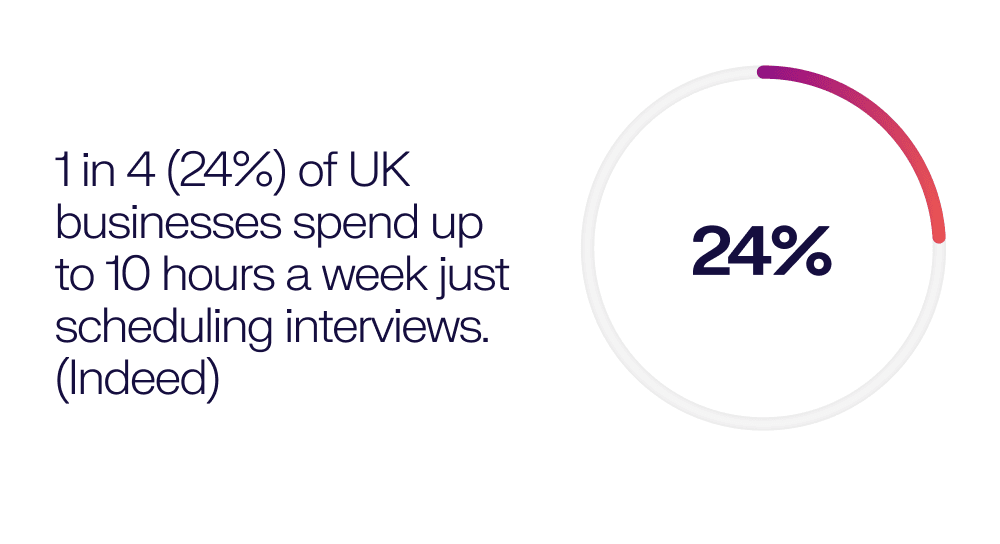
For example, consider the TA team who is swamped with applications (as well as proactively sourced candidates). There are tools that can automatically assign candidates to vacancies, to talent pools, and to the appropriate TA team member – so nobody has to manually check and allocate profiles.
By eliminating unnecessary steps and reducing paperwork, automation allows HR professionals to focus on more strategic activities, such as talent engagement and development, and organizational growth.
“Being able to free that [time] up so that all of our recruiters actually spend more time with candidates, with stakeholders, creating insights, becoming thought leaders, becoming the experts in their space, I think is a really amazing thing.” – Katharine Rooney, VP Talent Attraction & Acquisition, Mimecast
2. Encourage employee self-service 🙋🏽♀️
Another way to drive operational efficiency is to literally remove some tasks from your desk… and let employees do it themselves.
With platforms that allow employees to manage their own tasks and needs, such as updating personal information, submitting time-off requests, and enrolling in benefits programs, you can actually enhance the employee experience while saving HR teams’ time.
For example, if employees can access online learning courses, career development resources, and compliance checklists at their convenience, you will foster greater engagement and encourage more ownership over their own growth and well-being.
“We have heard from our business partners that even just them… generating the answer and going back with the link or the knowledge article or whatever – it is has saved them a bunch of time. So when you start to open the aperture [where employees] can access it directly, then business partners get to do the work they love, which I think is exciting.” – Caroline Heller, Senior Managing Director, Global Head of HR, BlackRock
For this to work, you need user-friendly, intuitive platforms that make self-service easy and accessible for all employees. Clear communication, training, and support are essential to ensure employees feel comfortable navigating the system, and robust security measures must be in place to protect sensitive data.
3. Take a skills-based view 💖
One of the most overlooked ways to drive efficiency is by taking a skills-based view of talent.
As the LinkedIn Talent Blog notes: “Sourcing and assessing candidates by skill (rather than by experience or education alone) results in a broader and more diverse talent pool, even as your search becomes more finely tuned to your specific needs.”
A skills-based organization can find efficiencies through hiring faster, finding talent more easily, and minimizing churn.
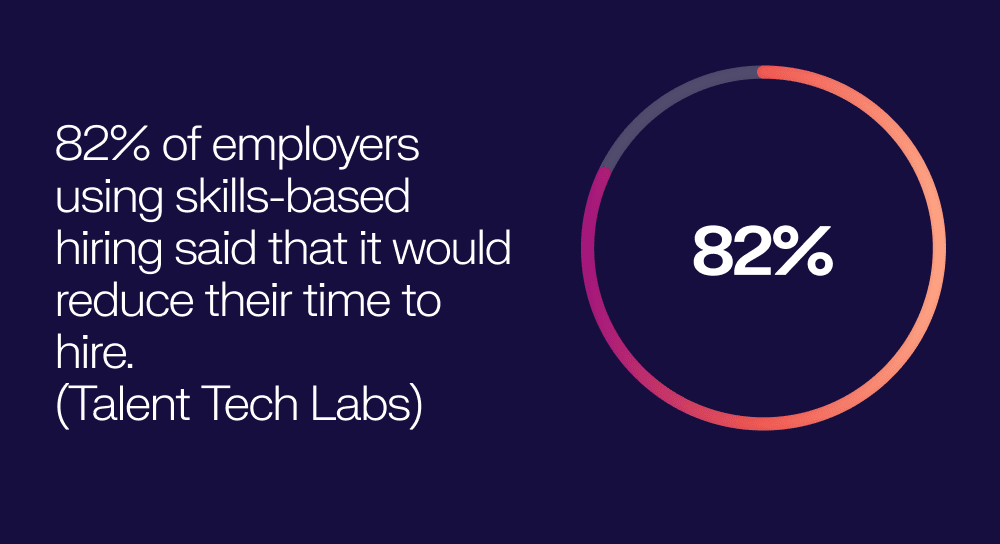
OneTen found that those using skills-first hiring practices found sourcing qualified candidates 2x easier.
Forrester reports that skills-based hiring criteria are five times more predictive of an individual’s future job performance than educational background and 2.5 times more predictive than work experience.
A skills-based approach not only reduces hiring costs but also allows organizations to better match employees with roles that align with their abilities and interests, leading to higher engagement and retention.
Instead of spending time and money hiring new talent, HR teams may be able to upskill or reskill current employees to fill talent gaps – and make efficiency gains for the business by holding on to people who are already onboarded, trained and productive.
Through leveraging skills data, HR teams can identify employees with adjacent skills who can be trained and redeployed where they are needed most, ensuring a more agile and efficient workforce.
4. Empower HR teams with data 📊
Talking of data: this is a really powerful tool for driving operational efficiency in HR.
With the right HR analytics tools, organizations can gather and analyze data on employee performance, retention, engagement, and more. This enables HR teams to not only move more quickly, but also to identify inefficiencies and areas for improvement with greater precision.
For example, data can be used to track turnover rates, identify patterns of absenteeism, and monitor employee engagement levels. With these insights, HR leaders can make informed decisions (quickly) about where to allocate resources, how to improve retention strategies, and which areas of the organization need additional support.
Within TA, analytics can start to paint a picture of where you are wasting your time and effort in terms of recruitment channels for different types of role. Understanding engagement with your Campaigns can help you optimize your sourcing strategies by focusing on the most effective channels and eliminating those that deliver poor results.
Predictive analytics tools can forecast future workforce needs, identify skill gaps, and suggest strategies to address potential challenges before they arise. Having a handle on the skills you need, have, and might need in the future is a surefire way to make HR operations more efficient.
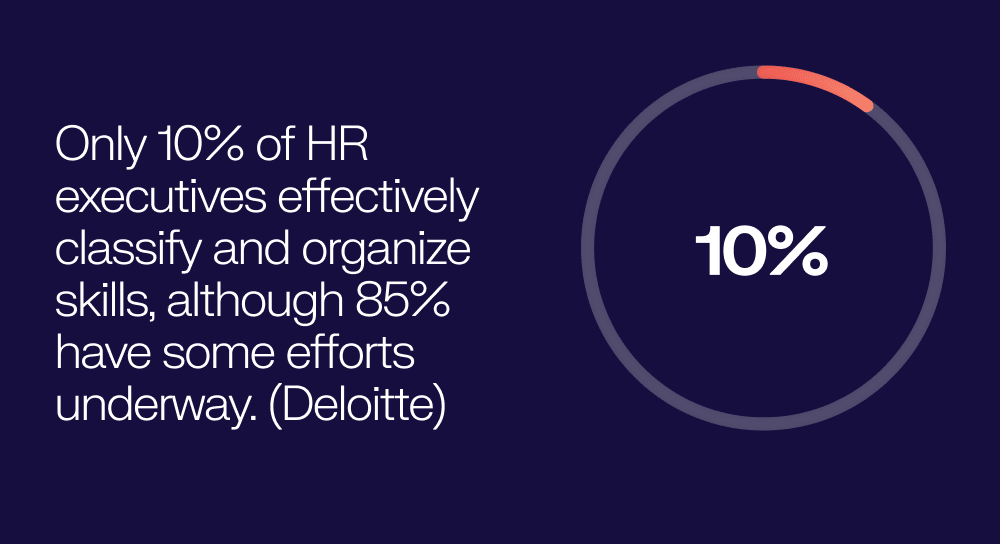
5. Centralize your HR systems 🧰
Centralizing HR systems is critical for managing data in an efficient way, and seeing the benefits enumerated here. Most organizations use a variety of disconnected tools and platforms to manage payroll, benefits, performance, and employee data. This fragmentation leads to inefficiencies, inconsistencies, and errors.
Employees spend 2.4 hours a week on finding information from multiple systems (because it isn’t all accessible through a single interface). (Wrike)
By implementing a centralized HR system, organizations create a single source of truth for all talent-related data. This reduces the need for manual data entry across multiple systems, ensures data accuracy, and improves compliance.
Centralized systems also make it easier to generate reports, analyze trends, and make informed decisions – quickly.
63% of HR executives say they are using “skills-related technology embedded in core HR information systems” – but just 33% say they have a single source of skills data across the entire workforce. (Deloitte)
6. Source talent proactively 🔍
It is clearly faster and easier to hire people who are already engaged with your employer brand.
See significant efficiency gains in recruitment by building a pipeline of qualified candidates before positions even open. Instead of reacting to vacancies and rushing to fill them, you can maintain a pool of vetted talent (hot leads) ready for immediate engagement.
How do you do this efficiently and effectively?
- Use data and analytics to identify future hiring trends and skill gaps, allowing them to focus on building a pipeline of candidates in critical areas.
- Use specialized recruitment tools, such as AI-powered platforms, to continuously scan the market for passive candidates, even when there’s no immediate vacancy.
- Keep these contacts securely stored in a central repository (talent CRM), in order to avoid duplicated efforts across large TA teams, maintain compliance with data protection laws, and give you a ready source of potential applicants every time a new requisition is opened.
- Engage with talent through online communities, social media, and networking events further helps to cultivate relationships with potential candidates before they’re needed.
- Use smart technology to automate the sending of personalized emails to segments within your community, with relevant roles and content (and at a time when they are most likely to be looking for a new opportunity.)
Proactive sourcing (and regular engagement with talent pools) reduces time-to-hire, minimizes the costs associated with lengthy recruitment processes, and lessens the burden on hiring managers when urgent needs arise.
By continuously identifying and engaging potential candidates, HR teams can also target passive talent, ensuring access to high-quality candidates who may not be actively job-seeking.
7. Get comfortable with AI... 🤖
“It’s AI to assist our recruiters and our team to create efficiencies in day-to-day work, to ultimately enhance productivity, to enhance the candidate experience.” – Mike Rizzi, Senior Recruitment Marketing Manager, DraftKings
According to Gartner, 76% of HR leaders believe that if their organization does not adopt and implement AI solutions, such as generative AI, in the next 12 to 24 months, they will be lagging in organizational success compared to those that do. Most HR leaders plan to increase their use of AI within the coming year or so.
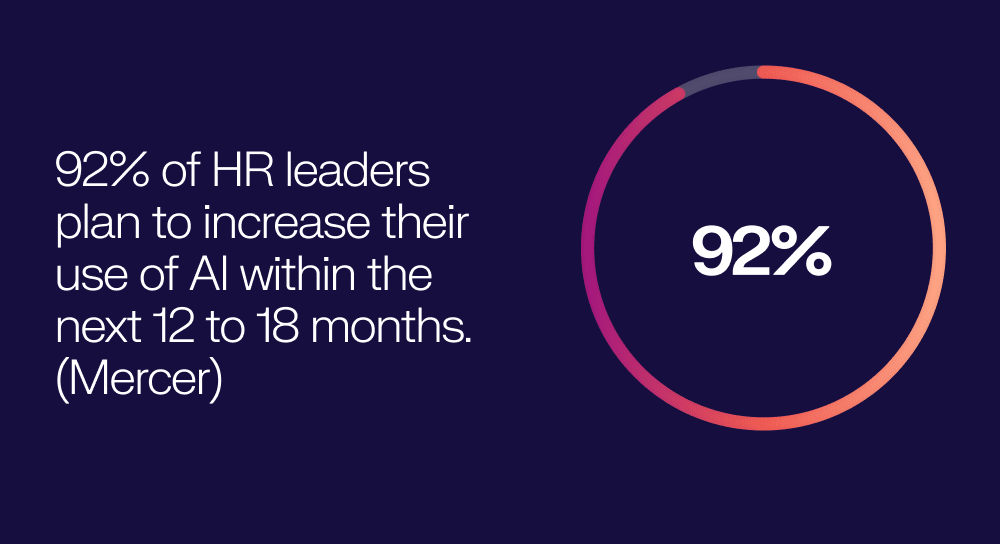
While some people harbor concerns about the way AI is “replacing” people in work contexts, it’s clear that AI can be a huge assistance to humans – augmenting jobs rather than stealing them. Business leaders are looking to empower people with AI rather than replace them: a LinkedIn study found that they’re 2x more interested in using AI to “increase productivity” than to cut headcount.
Among CEOs whose companies have broadly adopted generative AI, 84% believe it will increase efficiency in their employees’ time at work in 2024. (PWC)
Indeed, 62% of talent professionals surveyed by LinkedIn are “optimistic” about AI in recruitment, and the number of recruiters who added AI skills to their profiles jumped 14% last year.
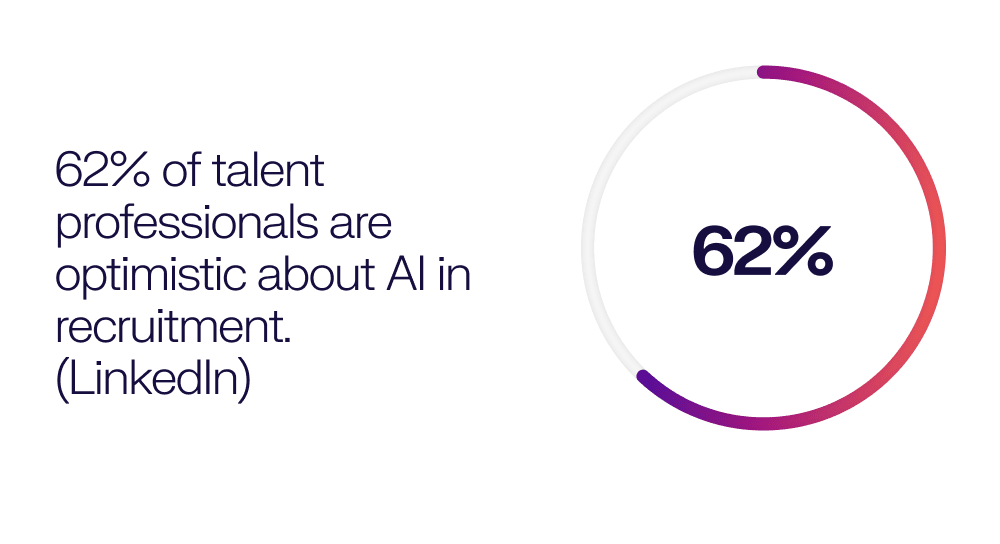
Today, AI-powered HR tools are revolutionizing the way organizations reach, engage and recruit talent.
- AI tools can sift through vast amounts of data to identify the best candidates quickly and accurately, reducing the time-to-hire and improving the quality of hires.
- AI algorithms analyze resumes, match them with job descriptions, and highlight top candidates – some who might otherwise be overlooked.
- AI can infer the skills someone is likely to have based on their previous experiences (work or training or something else) and can also suggest where people have potential to add a new skill (it would be adjacent to skills they possess currently).
- AI also enables more “predictive” hiring. By analyzing historical data on successful hires, AI can forecast which candidates are most likely to succeed in specific roles. This not only reduces turnover, aiding efficiency, but also ensures that new hires are a good cultural and organizational fit.
- In the interview process, AI can help identify the best questions and most relevant team members to be involved, as well as the scheduling mentioned above. New assessment technology enables skills evaluation during the screening process.
While 49% of people say they’re worried AI will replace their jobs, a massive 70% would delegate as much work as possible to AI to lessen their workloads. (LinkedIn)
✨ AI use cases beyond TA ✨
Beyond matching external candidates to roles, AI-powered tools can suggest whether an internal candidate should fill the role, or could be upskilled/reskilled to fill the demand.
On a wider scale, it can help you make important decisions about which markets to hire in, based on a range of factors, and spot risks and opportunities well in advance.
AI is also being used by some organizations to track employee performance and identify areas for improvement.
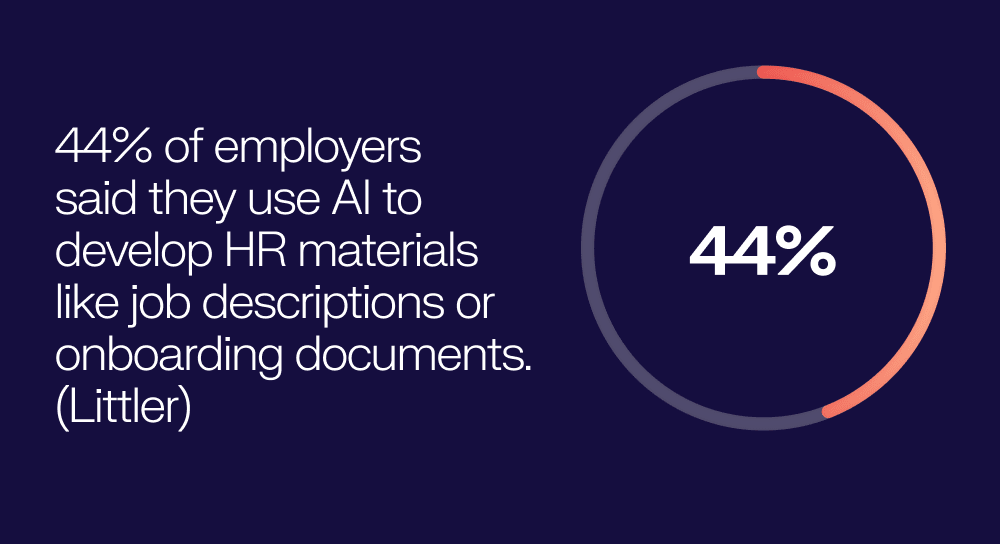
“We can actually open up capacity within the HR function to do what we’ve talked about for years, where we are strategic advisors, coaches, counselors across the business… and this is where I think AI is going to change it drastically for HR.” – Sam Hammock, EVP, Chief Human Resources Officer, Verizon
Of course, generative AI can also support in all kinds of content creation – from job descriptions and candidate communications to lesson plans.
More specifically, when it comes to L&D content development, tools are enabling dynamic content creation from documents, including synthetic voice and video.
Every route to greater HR efficiency noted above – from automating routine tasks and allowing employee self-service, to managing data and moving to a skills-first view – becomes easier to achieve when you deploy the right AI solutions.
How Beamery improves HR efficiency...
- We provide an AI-powered skills-based approach, adapted to your own organizational data... making it quick and easy to find the best person, and the best hiring strategy, for every role.
- The Beamery platform gives you a single source of truth for talent data, letting you make better informed talent decisions, faster.
- Relevant decision-makers and stakeholders can collaborate and take action with confidence, with data and insights presented in the flow of work. Unified workflows and a slick user experience means there is far less jumping between systems.
- Information is presented in a role-relevant way, integrated with key HR systems to enhance adoption and productivity, and helping you realize more value from your existing HR ecosystem.
Driving operational efficiency in HR requires a combination of technology, data-driven decision-making, and a focus on talent optimization. By automating routine tasks, investing in AI-powered tools, and taking a skills-based approach to workforce management, HR teams can not only improve their own efficiency but also contribute to the overall success of the organization.